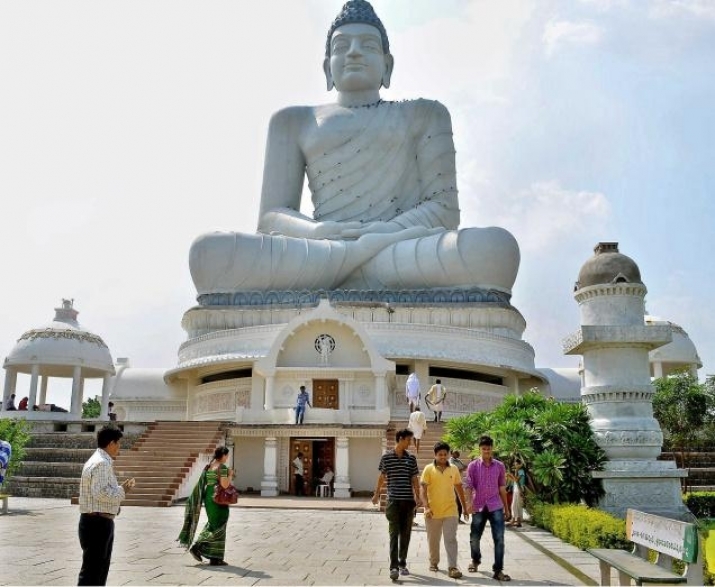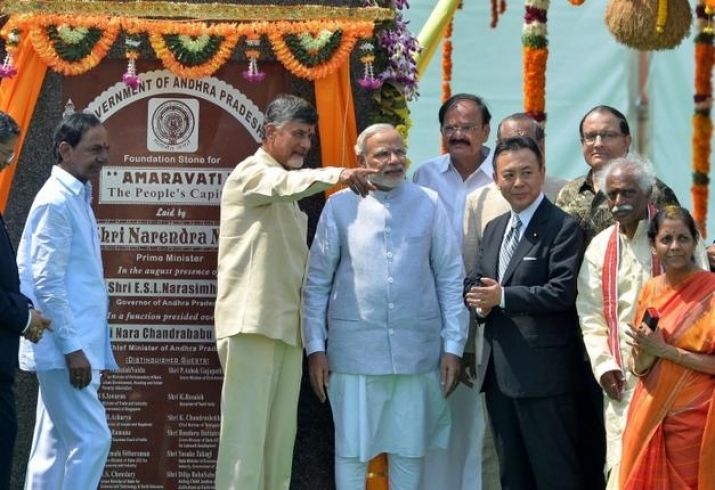NEWS
Buddhist Relics on Display in Andhra Pradesh’s Proposed New Capital Amaravati
 The 125-foot Dhyana Buddha statue at Amaravati. From thehindu.com
The 125-foot Dhyana Buddha statue at Amaravati. From thehindu.comA collection of Buddhist relics previously stashed away at the Archaeological Museum in Amaravati—including items believed to be remains of the Buddha—has been placed on public display as part of activities to mark the foundation ceremony for the proposed new capital of the Indian state of Andhra Pradesh, held on 22 October. The ceremony was attended by a host of dignitaries, including Indian prime minister Narendra Modi, who laid the foundation stone.
The proposed state capital, which sits on the southern bank of the Krishna River, was a renowned center of Buddhist learning from the 2nd century BCE to the 3rd century CE. The historic site is home to the Amaravati stupa, now in ruins, which was built during the reign of the Indian emperor Ashoka (r. c. 268–232 BCE). Aiming to increase tourism in the region, the government of Andhra Pradesh plans to establish a “Monastery Boulevard” in Amaravati as an international hub of Buddhism where different Buddhist orders can build monasteries and temples, similar to Bodh Gaya in the northeastern Indian state of Bihar. Modi also hopes that Amaravati will become a model for the government’s initiative to develop 100 “smart cities” in India.
According to a museum official, the relics were originally discovered inside a stupa at Bhattiprolu, in the same (Guntur) district. R. Amarendra Kumar, executive director (projects) at Andhra Pradesh Tourism Development Corp., a state government agency, said that chief minister N. Chandrababu Naidu had wanted the relics to be showcased “since prime minister Narendra Modi and dignitaries from all across the country and abroad” would be attending the ceremony. (The Hindu)
 Indian prime minister Narendra Modi at the foundation ceremony for Andhra Pradesh's planned new capital of Amaravati. From thehindu.com
Indian prime minister Narendra Modi at the foundation ceremony for Andhra Pradesh's planned new capital of Amaravati. From thehindu.comThe exhibition, which will run for a month, also depicts the past, present, and future of Amaravati, with a model of the future state capital and replicas of historic Buddhist sculptures from the area. A collection of ancient coins from dynasties such as the Pallava, Vishnukundina, and Vijayanagara kingdoms will also be on display.
Speaking at the ceremony, Japan’s state minister of economy, trade, and industry (METI) Yosuke Takagi said: “We in Japan from our young days have learned that this great land of Amaravati was a great seat of learning for Buddhism right from 3rd century [BCE], and here is where the seed of [the] Japanese nation’s culture and values have emerged. In our text books we learned that Nagarjuna (one of the most important Buddhist philosophers after the Buddha) visited the city. Amaravati is once again set to become a vibrant centre and [a] great city, and this time Japan is here to help a lending hand [sic] with experience and technology here to contribute to this great city.” (The Economic Times)
The site of the foundation ceremony is dominated by a 125-foot statue of the Buddha in meditation, described by The Hindu as the new face of “Brand Amaravati” and the “crowning glory” of the state’s planned capital. Built inside the statue is a museum with reliefs of famous sculptures depicting events from the life of the Buddha.
See more
Amaravati is ours (The Hindu)
Buddhist relics to be displayed at fete (The Hindu)
Dhyana Buddha to be the cynosure (The Hindu)














